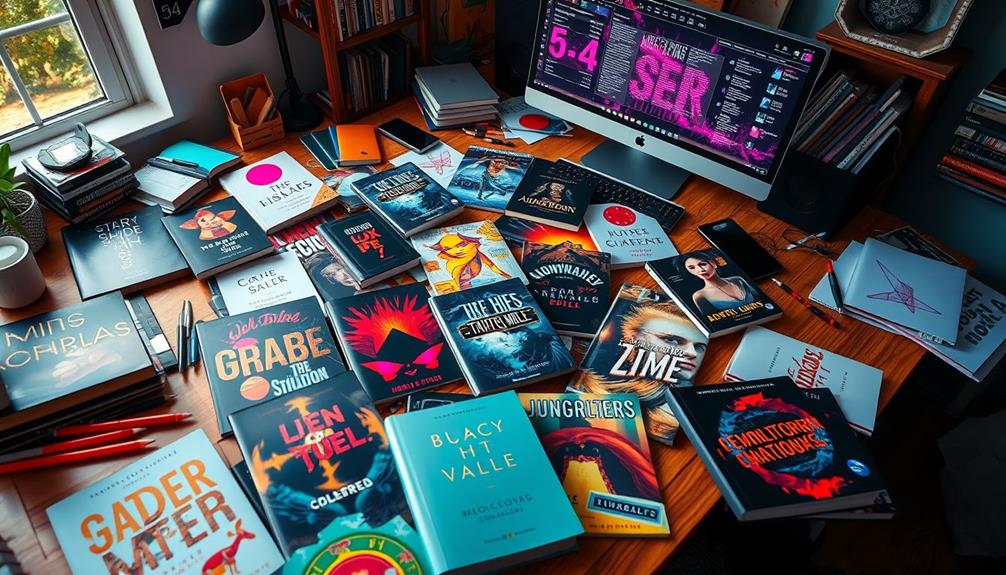Financial Success
Unlock AI Power: How Senior Authors Can Use Tech to Skyrocket Book Sales
With AI tools at their fingertips, senior authors can revolutionize their writing and marketing strategies—discover how to unleash this potential.

You can harness AI's power to streamline your writing process and supercharge your book sales. Use tools like ChatGPT for quick manuscript drafts and Grammarly to guarantee polished writing. Enhance reader engagement with AI-generated visuals and targeted marketing strategies based on data analytics. Social media platforms help connect with readers, driving loyalty and repeat sales. Consider automating your email campaigns to boost open and click-through rates. Finally, keep an eye on market trends to align your stories with reader preferences. There's so much more to explore about leveraging technology for your success in the publishing world.
Key Takeaways
- Utilize AI tools for streamlined manuscript drafting, cutting writing time to just 3 to 8 hours, allowing for faster publication.
- Engage readers with AI-generated images and interconnected book series, enhancing visual appeal and boosting sales potential.
- Implement data-driven marketing strategies by analyzing reader demographics and purchasing patterns for targeted promotions.
- Leverage social media engagement to cultivate a loyal community, increasing visibility and sales through consistent interaction and appealing content.
- Automate email marketing campaigns with personalized content to maximize engagement and drive higher transaction rates among readers.
Embracing AI in Writing

Embracing AI in writing can transform your creative process and boost productivity. By leveraging powerful AI tools like ChatGPT and Claude, you can generate text quickly, often finishing a book in just 3 to 8 hours. This efficiency allows you to focus on refining your ideas rather than getting bogged down by lengthy writing sessions.
Additionally, incorporating insights from thematic coherence in albums can inspire you to create more engaging narratives that resonate with your audience.
When you hit a wall, AI technologies can help overcome writer's block by providing initial prompts and ideas, reigniting your motivation. Plus, using AI for editing with tools like Grammarly guarantees your writing style remains consistent, lightening the load on professional editors by preparing cleaner drafts.
AI tools also aid in character development, helping you create organized character bibles that make it easier to manage details throughout your story.
Furthermore, by analyzing market trends and reader demographics, AI offers invaluable insights that can inform your marketing strategies, ultimately leading to increased book sales.
Integrating AI into your writing routine not only enhances your creativity but also streamlines your workflow, making you a more efficient author. Embrace these technologies and watch your writing process flourish.
Enhancing Reader Engagement

Engagement is the heartbeat of successful storytelling, and senior authors can harness AI to deepen their connection with readers. By creating interconnected book series through AI-generated content, you can entice readers to explore multiple titles, just like a publisher that saw 574 sales with many readers purchasing over 30 books each.
Additionally, exploring options like best ways for students to make money online can inspire innovative marketing approaches. Utilizing AI tools to enhance your storytelling allows you to produce unique ebooks that immerse readers in rich, imaginative worlds.
Analyzing reader demographics through platforms like Gumroad helps you tailor your marketing strategies to better connect with readers, driving repeat purchases. You can also incorporate AI-generated images alongside your text, increasing visual appeal and capturing interest. This approach not only enriches the reading experience but also boosts engagement and sales.
Focusing on short fiction and encyclopedia-style entries can attract diverse readerships, keeping readers invested in your evolving narrative universe. By employing these AI techniques, you'll enhance reader engagement, create loyal fans, and ultimately skyrocket book sales.
Embrace the power of AI to transform how you connect with readers and elevate your storytelling to new heights.
Streamlining the Creative Process

Many authors find themselves bogged down by the tedious aspects of writing, but AI can revolutionize your creative process. By using AI tools like ChatGPT and Claude, you can notably cut down the time needed to draft your book, completing a manuscript in as little as 3 to 8 hours. This efficiency has led to impressive results, with some authors publishing 97 books in just nine months.
Additionally, incorporating AI-driven storytelling techniques can improve narrative depth and engagement with readers.
Furthermore, using AI for image generation, such as Midjourney, can enhance your storytelling. You'll gain access to 40 to 140 unique visuals per book, adding depth to your narrative and enriching your reader's experience.
AI also helps with character development; it can create detailed character bibles that keep your character information organized and easily retrievable, speeding up your writing process.
When you hit writer's block, AI-generated prompts and sentence starters can provide the motivation you need to push through.
Plus, by using AI for editing tasks, you can maintain a consistent style and quickly identify grammatical errors, preparing cleaner drafts that require less intensive revision before reaching professional editors.
Embrace these tools, and watch your creative process streamline dramatically.
Overcoming Challenges With AI

While streamlining your creative process with AI tools can boost productivity, challenges still arise in the writing journey. One of the most common hurdles you face is overcoming writer's block. Fortunately, AI can be a game-changer. By generating initial ideas or even complete sentences, these tools help you kickstart your writing. Instead of staring at a blank page, you can leverage AI's suggestions to find your voice and regain momentum.
Engaging with curiosity and happiness can enhance your creative flow, allowing you to approach your writing with a more positive mindset.
Additionally, AI can automate character development and organization, allowing you to focus on crafting complex narratives. This not only enhances your storytelling depth but also keeps your readers engaged, leading to higher retention and repeat purchases.
You'll also find that AI's editing capabilities maintain your writing quality while cutting down on costs associated with hiring professional editors.
Embracing these technologies minimizes the time you spend on content creation, empowering you to publish more frequently. In just a few hours, you could have a polished book ready to share with your audience.
Data-Driven Marketing Strategies

To effectively reach your readers, understanding your target audience is essential.
By harnessing data analytics, you can enhance your social media engagement and design email marketing campaigns that truly resonate with their interests.
Implementing a budgeting strategy for your marketing efforts can help allocate resources efficiently.
This approach not only boosts your visibility but also fosters lasting connections with your audience.
Target Audience Analysis
Understanding your target audience is essential for effective marketing, and leveraging data-driven strategies can greatly enhance your approach. By analyzing reader demographics through platforms like Gumroad, you can gain valuable insights that inform your marketing tactics. For instance, used AI tools to summarize market research can help you identify key trends and preferences among your readers.
Here's how you can analyze your audience effectively:
| Strategy | Insight Gained | Action to Take |
|---|---|---|
| Reader Demographics | Age, gender, location | Tailor your promotional content |
| Purchasing Patterns | Repeat buyers and their preferences | Create targeted promotions |
| Reader Feedback Analysis | Common themes in reviews | Refine your writing and marketing |
Social Media Engagement
Analyzing your target audience sets the stage for effective social media engagement, which can dramatically boost your book's visibility. With 70% of readers discovering new authors through social media interactions, you can't afford to overlook this powerful tool.
By utilizing data analytics tools, you can track reader engagement and tailor your content, potentially increasing your conversion rates by 20%. Additionally, employing effective email marketing strategies can complement your social media efforts, allowing for a more thorough outreach approach.
Consistent posting and interaction are key to cultivating a loyal community. In fact, 60% of authors report higher sales from repeat readers who feel a connection through social media. Engaging directly with your audience not only boosts visibility but also fosters loyalty.
Consider running targeted ad campaigns on platforms like Facebook and Instagram. These campaigns can yield an impressive ROI of up to 400%, especially when you focus on niche audiences interested in your genre.
Additionally, incorporating user-generated content—like reader reviews and fan art—can enhance authenticity and lead to a 30% increase in engagement rates.
In short, when you prioritize social media engagement, you build a vibrant community that will help skyrocket your book sales. Embrace this strategy, and watch your readership grow.
Email Marketing Campaigns
Harnessing the power of email marketing campaigns can greatly elevate your book sales and reader engagement. With an average ROI of $42 for every $1 spent, it's one of the most cost-effective strategies for authors like you.
Start by segmenting your email lists based on reader demographics and purchase history. This simple step can boost your open rates by 14% and double your click-through rates, enhancing overall engagement. To boost your success further, consider utilizing SMART criteria for your campaign goals, making sure they're specific and measurable.
Personalization is key in email marketing campaigns. Tailoring your content can increase transaction rates sixfold compared to generic messages, encouraging repeat purchases from your loyal readers.
Don't forget to include book release announcements and exclusive content to drive urgency; studies reveal that 60% of consumers feel motivated to buy when they see limited-time offers.
Automating your email campaigns with targeted follow-ups not only saves you time but guarantees your readers receive timely notifications about new releases or special promotions.
Crafting Compelling Book Covers

Creating a striking book cover is essential for capturing readers' attention in a crowded market. When you're crafting compelling book covers, consider how engaging visuals and typography reflect your book's genre. Incorporating elements that evoke specific moods, much like how essential oils for toothache relief can soothe discomfort, can make your cover more appealing.
Research shows that 75% of readers view a book's cover as a key factor in their purchasing decision, so you want yours to stand out.
Utilizing AI tools like Midjourney can greatly enhance your design process. These tools allow you to generate multiple design concepts quickly, enabling you to experiment with different styles and layouts to find the most appealing option for your target audience. You can save time while boosting creativity.
Incorporating AI-driven analytics provides insights into visual trends and preferences within specific genres, ensuring your cover resonates with potential readers. A well-crafted book cover, supported by AI technology, not only enhances your creativity but also increases your book's visibility and sales.
Utilizing Social Media Effectively

With an enchanting book cover in place, it's time to turn your attention to social media—a powerful tool for connecting with readers and promoting your work. Senior authors like you can tap into platforms such as Facebook, Twitter, and Instagram, where 73% of adults aged 50 and older actively engage. This means you have a ready audience enthusiastic for your stories.
Additionally, consider leveraging the growing demand for AI Cybersecurity Jobs to guarantee your online presence is secure while you engage your audience.
Utilizing targeted advertising on Facebook is a number one strategy. It allows you to reach specific demographics interested in your genre, maximizing your book's visibility. Regularly engage with your followers through posts, live Q&A sessions, and behind-the-scenes glimpses into your writing process. This fosters a sense of community and encourages repeat purchases—many authors see higher sales from active engagement.
Don't forget the power of visuals! Posts with appealing graphics or AI-generated images get 94% more views, so make your content shareable.
Building a Strong Author Brand

Building a strong author brand is essential for connecting with your readers and standing out in a crowded marketplace. To achieve this, focus on consistently producing quality content.
For instance, the dedication and commitment often reflected in various health trends, such as Cranberry Juice Consumption, can also apply to writing, as regular engagement can enhance your connection with your audience.
Look at the success of AI-assisted authors who published 97 books in just nine months, attracting a loyal readership. Engaging with readers through interconnected book series can foster brand loyalty, as many buyers from this journey have purchased over 30 titles, showcasing the power of a cohesive brand narrative.
Leverage social media and platforms like Gumroad for direct sales. These tools give you valuable insights into reader demographics and preferences, enhancing your branding efforts.
Don't hesitate to incorporate unique elements like AI-generated visuals and innovative storytelling techniques. This approach helps differentiate your author brand in a competitive market, as seen in books featuring up to 140 AI-generated images.
A well-defined author brand can lead to increased sales and repeat purchases. In fact, the nearly $2,000 generated from 574 book sales in just nine months highlights the impact of strategic branding on revenue.
Build your brand, connect with your readers, and watch your book sales soar.
Analyzing Market Trends

When you analyze market trends, you can uncover reader preferences that help shape your writing and marketing strategies.
By tracking sales patterns and leveraging data analytics, you gain insights into what resonates with your audience.
This approach not only boosts your book's visibility but also enhances your ability to connect with specific demographics effectively.
Identifying Reader Preferences
Understanding reader preferences is essential for authors aiming to succeed in a competitive market. By identifying reader preferences, you can create content that resonates deeply with your target audience.
Utilizing AI tools allows you to efficiently analyze market trends and gather insights into what readers are currently craving. Platforms like Gumroad offer valuable data on reader demographics, enabling you to tailor your writing to align with specific interests.
AI can sift through large volumes of market research, highlighting emerging genres and popular themes. This data-driven approach helps you stay ahead of the curve and adapt your writing to meet the demands of your audience.
Moreover, analyzing sales data reveals patterns in reader behavior, such as repeat purchases, which can inform your future releases and pricing strategies.
With AI-driven insights into the competitive landscape, you can position your books effectively, enhancing visibility and making them more appealing to potential readers.
Tracking Sales Patterns
Tracking sales patterns is essential for authors who want to maximize their book sales and appeal to their audience. By analyzing these patterns, you can identify which genres or themes resonate most with readers, allowing you to create more targeted content.
Platforms like Gumroad provide invaluable sales data, helping you understand reader demographics and tailor your marketing strategies effectively.
Look closely at pricing as well; studies show that ebooks priced between $1.99 and $3.99 tend to perform best. This insight can guide your future pricing strategies and boost sales.
Additionally, monitoring sales trends over time reveals the effectiveness of your promotional efforts. For instance, if 574 books sold generated nearly $2,000 in revenue, that's a clear signal to refine your outreach.
Utilizing Data Analytics
Data analytics has revolutionized how authors approach market trends, giving you the power to make informed decisions that align with reader preferences. By leveraging AI tools, you can take advantage of large datasets from sales, reader demographics, and competitor performance, providing you with actionable insights.
This means identifying popular genres and themes, allowing you to tailor your storytelling to current reader interests and boost your potential sales.
Additionally, data analytics helps you optimize your book pricing strategies. By analyzing pricing trends, you can set your book's price between $1.99 and $3.99, maximizing revenue while appealing to price-sensitive readers.
You can also track reader engagement metrics like repeat purchases and reading habits, enabling you to create interconnected book series. This fosters reader loyalty and encourages them to explore multiple titles.
Moreover, data-driven insights can inform your marketing strategies. With targeted promotions and advertising, you can effectively position your books in a competitive landscape, reaching new audiences enthusiastic for your stories.
Essentially, utilizing data analytics not only enhances your writing but also greatly elevates your book sales potential.
Future of AI in Publishing

The future of AI in publishing is bright, promising a revolutionary shift in how stories are created and consumed.
As a senior author, you can harness this technology to enhance your work and reach wider audiences. You might be trying to keep up with trends, but embracing AI tools can greatly boost your output and efficiency.
Consider these key aspects:
- Increased Output: AI can assist in producing multiple books in a fraction of the time, allowing you to focus on creativity.
- Enhanced Storytelling: With AI, you can explore intricate world-building and narrative structures that were once challenging to create.
- Reader Engagement: The shift towards co-creation means your readers can actively influence narratives, making them feel more connected to your work.
- Expanded Creativity: As more artists adopt AI, the storytelling landscape diversifies, paving the way for innovative formats and transmedia experiences.
Frequently Asked Questions
Is It Illegal to Sell a Book Written by Ai?
Selling a book written by AI isn't illegal, as long as you retain rights to the content. However, check local copyright laws and any specific guidelines from platforms or publishers before proceeding.
Can You Use AI to Write a Book and Sell It?
Yes, you can use AI to write a book and sell it. By leveraging AI tools, you'll boost your creativity, streamline your writing process, and potentially increase your sales through engaging content and effective marketing strategies.
Does KDP Allow AI Written Books?
As of October 2023, KDP allows AI-written books, reflecting a growing trend where 30% of readers prefer innovative content. Just guarantee you disclose any AI-generated material and comply with copyright laws to publish successfully.
What Is the Best AI Tool for Writing a Book?
The best AI tool for writing a book depends on your needs. If you want text generation, try ChatGPT. For visuals, use Midjourney. Explore tools like Grammarly for editing and refining your drafts effortlessly.
Conclusion
Incorporating AI into your writing journey can truly transform your book sales. Did you know that authors who use AI tools report a 30% increase in reader engagement? By embracing technology, you can enhance creativity, streamline processes, and connect with your audience like never before. As you navigate the ever-evolving publishing landscape, remember that leveraging data-driven marketing and social media can amplify your author brand. Don't miss out on the AI revolution—your next bestseller could be just a click away!
Financial Success
29 an Hour Is How Much a Year
Keen to discover how a $29 hourly wage translates into annual earnings? Uncover the details that could shape your financial future!

If you earn $29 an hour, you're looking at about $60,320 a year! That's fantastic news for planning your family's budget and enjoying life's little moments. Here's how it breaks down:
- Hourly Wage: $29
- Hours per Week: 40
- Weeks per Year: 52
This is a great salary compared to many jobs, giving you more opportunities for fun family activities! Don't forget, taxes and benefits can change your take-home amount. Curious about how the numbers work out in detail? Stick around, there's more info waiting for you!
Key Takeaways
- At $29/hour, working 40 hours a week for 52 weeks yields an annual salary of $60,320.
- If you work fewer hours, such as 30 hours a week, your annual salary would be $45,360.
- This salary is above the average U.S. salary of $53,490, indicating competitive earnings.
- Consider tax implications; effective tax rates for this income may range from 12% to 22%.
- Benefits and employer contributions can significantly enhance total compensation beyond the hourly wage.
Annual Salary Calculation

Calculating your annual salary from an hourly wage is simpler than it might seem. Just remember a few easy steps! To find your salary, you can use this formula: Annual Salary = Hourly Wage × Hours per Week × Weeks per Year. Most people work 40 hours a week and 52 weeks a year, so it's a great starting point.
- If you earn $25 an hour, your annual salary would be $52,000! (That's 25 × 40 × 52.)
- What if you work fewer hours? If you earn $20 an hour but work only 30 hours a week, your annual salary would be just $31,200.
- Even the federal minimum wage of $7.25 per hour gives you about $15,080 if you work full-time.
Don't forget to adjust if you take unpaid time off! It's important to calculate based on the actual hours worked throughout the year.
Hourly to Salary Conversion

Understanding how to convert your hourly wage into an annual salary can help you better assess your financial situation and make informed decisions.
It's pretty simple! To find your equivalent annual salary, just use this formula: Annual Salary = Hourly Wage × Hours per Week × Weeks per Year. For most full-time jobs, that means 40 hours a week and 52 weeks a year.
Here's a quick example: If you earn $25 an hour, you'd make $52,000 a year! That's $25 multiplied by 40 hours, multiplied by 52 weeks. How cool is that?
And if your hourly rate is $30, you're looking at an annual salary of $62,400! Wow!
Remember, if you take unpaid leave or work extra hours, the total number of hours can change, which might affect your final calculation.
Knowing how to do this conversion is super important for budgeting and comparing job offers. It gives you a clear picture of your overall compensation based on your hourly pay rates.
Comparison to Median Salaries

When you compare your hourly wage to median salaries, it can provide valuable context about your earning potential. For instance, if you earn $20 per hour, that adds up to about $41,600 per year. While that's below the median salary of $59,228, which breaks down to around $28.49 per hour, it's still a solid income in many places.
Here are some key points to reflect on:
- The average U.S. salary is about $53,490, or $25.69 per hour. This shows how close you might be to the average worker.
- Gender wage gaps exist, with men earning about $1,227 per week compared to women's $1,021. It's important to think about fair pay for everyone!
- Your location matters, too! Salaries can change based on where you live and what skills are in demand.
Tax Considerations

Steering through tax considerations can feel overwhelming, especially when you're trying to determine how much of your annual salary will actually end up in your pocket. Understanding taxes is essential, and it can make a big difference in your finances!
- Effective Tax Rate: If you earn $55,000 a year, your tax rate could range from 12% to 22% based on your income level. That means a part of your salary goes to taxes, but there's more to know! Additionally, understanding the IRA contribution limits can help you maximize your retirement savings and reduce your taxable income.
- Progressive Tax Brackets: The federal tax system is progressive. This means the more you earn, the higher the tax rate on the extra money you make. It's like climbing a ladder—each step has its own tax!
- Deductions and Credits: Don't forget about deductions! They can lower your taxable income. For example, the standard deduction or childcare credits can help you save.
- State Taxes: Some states have flat tax rates, while others use a progressive system too. Check your state's tax rules!
To accurately figure out your taxes, consult tax resources or professionals. They can help you understand your unique situation! Additionally, be sure to consider state tax implications when planning for IRA withdrawals, as it can significantly impact your overall tax burden.
Benefits Beyond Salary

While managing tax implications is important for grasping your net income, it's equally essential to recognize the full range of benefits your employer may offer.
These benefits can transform your overall compensation package, adding 20-30% or more to your total value! Here are some fantastic perks you might enjoy:
- Healthcare: A healthy body means a happy life! Newborn feeding options can also influence your family's health and wellness. Additionally, emotional and psychological support available through employer-sponsored programs can enhance overall well-being.
- Retirement contributions: Saving for the future is super smart; consider how integrating IRAs with state-specific benefits can enhance your savings potential.
- Paid time off: Enjoy those well-deserved vacations!
- Flexible work schedules: Balance work and family time with ease.
- Remote working options: Work from the comfort of home.
- Professional development: Learn new skills and grow your career.
- Performance bonuses: Earn extra cash when the company does well.
- Non-monetary benefits: Look for student loan help or wellness programs.
Understanding these benefits can help you make smart choices when comparing job offers. Additionally, assessing your net worth is crucial to appreciate the overall impact of these benefits on your financial future.
It's not just about the salary; it's about the total value of your compensation packages! By knowing your options, you can negotiate better terms and guarantee your hard work pays off in more ways than one.
Frequently Asked Questions
What Is $50,000 a Year Hourly?
To find your hourly wage from a $50,000 annual salary, divide that amount by 2,080 hours. You'll discover that you earn about $24.04 per hour before taxes and deductions.
What Is $70,000 a Year Hourly?
They say time is money. If you earn $70,000 a year and work 40 hours a week, you're making about $33.65 an hour. That's a solid wage for many industries.
What Salary Is $100 per Hour?
If you earn $100 per hour, you're looking at an annual salary of about $208,000. That means you'll make roughly $4,000 weekly and around $17,333 monthly, considerably above the average U.S. salary.
What Is $30 an Hour Annually?
You know what they say, "A penny saved is a penny earned." If you earn $30 an hour and work full-time, you'll make around $62,400 annually, giving you a solid financial foundation for planning.
Conclusion
So, if you earn $29 an hour, you could make about $60,000 a year! Isn't that exciting? It's important to remember that while salary is great, benefits and job satisfaction really matter too. Plus, when you know how much you're making, you can plan for fun family adventures or save for that dream vacation! Always keep an eye on your total earnings and how they can help you enjoy life to the fullest. Happy budgeting!
Financial Success
33 an Hour Is How Much a Year
The potential earnings of $33 an hour may surprise you, but there’s more to uncover about maximizing your financial future.

If you earn $33 an hour, that's a wonderful start! Working full-time at that rate adds up to about $68,640 each year. Here's how it breaks down:
- Hourly Rate: $33
- Hours Per Week: 40
- Weeks Per Year: 52
Just multiply those together! This amount can help you plan family activities or save up for fun adventures. Keep in mind, taxes and other deductions may change your take-home pay, but isn't it exciting to know what you could earn? Keep exploring to uncover more about managing your finances!
Key Takeaways
- To calculate annual salary: $33/hour × 40 hours/week × 52 weeks/year equals $68,640/year.
- This figure assumes full-time work without unpaid time off or part-time adjustments.
- $33/hour is significantly above the average U.S. salary of $25.68/hour in 2023.
- Understanding annual salary helps in financial planning and budgeting for family activities.
- Tax considerations will affect take-home pay, as federal rates range from 10% to 37%.
Annual Salary Calculation

When you want to convert an hourly wage into an annual salary, you can use a simple formula: Annual Salary = Hourly Wage × Hours per Week × Weeks per Year. It's a fun way to see how much you could earn each year!
For example, if your hourly wage is $25, just multiply that by 40 hours per week and 52 weeks in a year. That gives you an equivalent annual salary of $52,000. Isn't that neat?
Here's a quick breakdown:
- Hourly Wage: $25
- Hours per Week: 40
- Weeks per Year: 52
- Equivalent Annual Salary: $52,000
But wait! If you work part-time or take some unpaid time off, you'll need to adjust the weeks in the formula. This way, you can get a more accurate picture of your earnings.
Understanding how to calculate your annual salary is super important for budgeting and planning family fun activities!
Just remember, this formula doesn't include taxes or deductions, so your take-home pay might be different. Happy calculating!
Breakdown of Earnings

Understanding the breakdown of your earnings can help you make informed financial decisions.
When you know how your hourly rate translates into your annual salary, you can better manage your budget and plan for the future.
Let's explore how different hourly rates can impact your yearly earnings based on the hours you work.
- At $10 per hour, your annual salary is about $20,800.
- If you earn $15 per hour, that jumps to around $31,200!
- A $26.44 hourly rate means you'd make approximately $55,000 each year.
- Earning $30 per hour boosts your salary to about $62,400!
Comparison to Average Salaries

Comparing your hourly wage to average salaries can provide valuable insight into your earning potential.
If you earn around $25.68 per hour, you're right at the average salary in the U.S. for 2023, which is about $53,490. Isn't that neat?
If you make $30 an hour, your annual salary jumps to $62,400, which is pretty exciting since it's well above average!
Here's a quick look at how hourly wages compare to salaries:
- $25.68/hour = $53,490/year (average)
- $26.44/hour = $55,000/year (slightly above average)
- $30/hour = $62,400/year (significantly above average)
Tax Considerations

Earning a competitive hourly wage not only boosts your annual salary but also brings tax implications that can impact your take-home pay.
When you know how much an hour is how much regarding yearly earnings, you'll need to take into account taxes! Here are some important tax considerations to keep in mind:
- Federal Tax Brackets: These range from 10% to 37%, depending on your income level.
- Effective Tax Rates: If you earn $55,000 annually, expect an effective tax rate of around 12% to 22%, which could mean owing between $6,600 and $12,100 in federal taxes.
- Deductions Matter: The standard deduction for single filers in 2023 is $13,850, which can lower your taxable income.
- State Taxes: Depending on where you live, state tax rates can vary widely, from 1% to over 10%, or even none at all!
Understanding these factors can help you plan better and keep more of your hard-earned money.
Tools for Salary Conversion

When you need to convert an hourly wage into an annual salary, several handy tools can simplify the process. One of the most popular options is the Hourly to Salary Calculator. This tool quickly calculates your annual earnings by multiplying your hourly rate by the total hours worked in a year, which is usually 2,080 for full-time jobs.
Here's a quick way to do it on your own:
– Use the formula: Annual Salary = Hourly Wage × 40 hours/week × 52 weeks/year.
Remember, this gives you a clear picture of your earnings based on a standard work schedule!
Additionally, many payroll software solutions have built-in salary conversion tools, making it easy to compare different pay structures. Salary comparison websites also help you find industry-specific benchmarks, so you can see if your pay matches others in your field.
Plus, financial planning apps often feature salary conversion tools that assist in budgeting, showing your hourly earnings in monthly and annual figures. Understanding your retirement savings plan is crucial for long-term financial health, especially when converting between pay structures.
With these resources, you're all set to tackle salary conversions with confidence!
Frequently Asked Questions
What Is $50,000 a Year Hourly?
To find out how much $50,000 a year is hourly, you divide it by 2,080 work hours. This gives you roughly $24.04 per hour, helping you gauge your compensation accurately.
What Is $70,000 a Year Hourly?
You might think $70,000 feels overwhelming, but it breaks down to about $33.65 per hour. Understanding this helps you budget better and assess job offers, ensuring you're making informed financial decisions for your future.
What Salary Is $100 per Hour?
If you're earning $100 per hour, you're looking at an annual salary of about $208,000, assuming you work 40 hours a week for all 52 weeks. That breaks down to roughly $17,333 monthly.
What Is $30 an Hour Annually?
If you earn $30 an hour, you'll make about $62,400 annually before taxes. This assumes you work 40 hours a week for 52 weeks. Remember, taxes will impact your final take-home pay considerably.
Conclusion
So, if you think making $33 an hour seems like a dream come true, wait until you see it add up to over $68,000 a year! That's enough for a family vacation or a shiny new bike! Isn't it funny how a few hours of work can turn into so much joy? Just remember, while the numbers look great, don't forget to factor in taxes and expenses. Still, dreaming big has never felt so good!
Financial Success
57000 a Year Is How Much an Hour
Curious about what a $57,000 salary translates to hourly? Discover the financial insights that can transform your budgeting approach!

If you're wondering what a salary of $57,000 a year means for your hourly wage, it's around $27.40! This is based on a standard 40-hour workweek. Here's a quick breakdown:
- Yearly salary: $57,000
- Monthly: About $4,750
- Weekly: Roughly $1,096
Isn't that neat? Knowing how your salary converts can help with budgeting and planning for fun family activities! The more you understand about salaries, the better decisions you can make about your finances. Isn't that exciting? There's more to explore about this topic, so stick around!
Key Takeaways
- To find the hourly rate for a $57,000 annual salary, use the formula: Hourly Rate = Annual Salary / 2,080 hours.
- Dividing $57,000 by 2,080 hours gives an hourly rate of approximately $27.40.
- This calculation assumes a standard 40-hour work week over 52 weeks.
- Adjust the hours if working part-time or fewer weeks to get a more accurate hourly rate.
- Understanding this hourly rate aids in financial planning and evaluating job offers.
How to Calculate Hourly Rate

Understanding how to calculate your hourly rate can empower you to make informed financial decisions.
It's like having a magic calculator that helps you see the true value of your work! To find your hourly wage, start with your annual salary. Simply take your salary and divide it by the total hours you work in a year. For most folks, that's 40 hours per week multiplied by 52 weeks, which equals 2,080 hours.
Here's a quick example: If your annual salary is $40,000, divide that by 2,080 hours, and you'll find your hourly rate is about $19.23.
If you work fewer weeks per year, like 50 weeks, just adjust your calculation. Use 2,000 hours (40 hours x 50 weeks) for a more accurate hourly wage.
Annual Salary Breakdown

Breaking down your annual salary into more manageable components can help you better grasp your financial situation.
It's exciting to see how your hard work translates into actual numbers! Let's look at some examples.
- An annual salary of $40,000 means you earn about $19.23 per hour.
- If you make $50,000 a year, your hourly wage is around $24.04.
- At $55,000, you'll be earning roughly $26.44 per hour.
- A salary of $60,000 gives you an hourly rate of about $28.85.
Now, let's break it down further into monthly and weekly salaries!
- For $40,000, your monthly salary is about $3,333.33 and weekly, it's $769.23.
- Earning $50,000 brings your monthly pay to $4,166.67 and weekly to $961.54.
Knowing your hourly rate and how it fits into your budget is essential for smart financial planning.
Understanding this salary breakdown helps you feel more in control of your compensation and spending.
Monthly to Hourly Rate Conversion

Converting your monthly salary to an hourly rate can give you a clearer picture of your earnings. To do this, you first multiply your monthly salary by 12. This tells you your annual salary!
Then, you use this formula: Hourly Rate = (Monthly Salary × 12) / (Hours per Week × Weeks per Year).
Let's say your monthly salary is $3,000. If you work a standard 40-hour work week and all 52 weeks of the year, your hourly rate would be about $17.31.
If you take some time off and only work 50 weeks, your hourly rate would actually be higher. That's because you're working fewer total hours!
Understanding this conversion is super important for evaluating compensation structures and job offers. You want to know if you're getting a fair deal!
A higher hourly rate could mean more money in your pocket, which is always a good thing. Additionally, considering state-specific benefits in your retirement planning can help you maximize your financial outcomes. So, next time you look at your monthly salary, remember to do the conversion. It can help you make better choices about your work and future!
Salary Comparisons: US and UK

When it comes to salary comparisons between the US and UK, many factors come into play, including median salaries and purchasing power.
Let's look at some interesting numbers!
- In the US, the median annual salary is about $59,228, which breaks down to a median hourly wage of around $28.50 for full-time workers.
- Meanwhile, in the UK, the median annual salary is roughly £34,963, translating to an hourly wage of about £16.82.
Even though both countries have similar economic conditions, the cost of living can change how much people can buy with their salaries.
It's crucial to recognize that gender wage disparities exist in both places. For example, men in the US earn a median weekly salary of $1,227, while women earn $1,021, which is just 83.2% of what men make.
Additionally, the average salary can vary greatly depending on the job.
Fields like healthcare and technology often pay more than retail or hospitality.
With all these factors, comparing salaries can be quite the adventure!
Additional Tools for Salary Calculations

Understanding your salary is only part of the equation; knowing how to calculate it accurately is just as important. Using tools like a salary to hourly calculator can make this process fun and easy! For example, take your hourly wage, multiply it by the hours worked per week, then multiply that by 52 weeks. Voila! You have your annual salary.
If you're curious about how your earnings stack up, online resources can show you the US median salary, which is about $59,228 annually. You can also adjust calculations for unpaid leave by changing the standard 52 weeks to a lower number. This helps with salary projections, giving you a clearer picture of what you might earn.
Don't forget about payroll tax calculators! These handy tools estimate your take-home pay after tax deductions, so you know what to expect in your pocket. Additionally, understanding your budgeting techniques can help you manage your earnings more effectively.
Here's a quick recap of tools to help:
- Hourly wage to annual salary calculator
- Salary to hourly calculator
- Payroll tax calculators
- Online resources for US median salary comparisons
With these tools, you're all set to master your salary calculations!
Frequently Asked Questions
What Is $70,000 a Year Hourly?
To find your hourly rate from a $70,000 annual salary, divide by 2,080 hours. You'll get about $33.65 per hour, helping you assess job offers and compensation effectively.
How Much Is $1400 a Year Hourly?
To find your hourly rate from $1,400 a year, divide that by the total hours you work. If you work full-time, it comes out to about $0.67 an hour—far below minimum wage.
How Much Is $100 000 a Year per Hour?
Imagine you're earning $100,000 a year. You divide that by 2,080 hours, and you're looking at about $48.08 an hour. It's a solid wage that reflects your hard work and dedication.
How Much Is $50,000 a Year per Hour?
To find out how much $50,000 a year is per hour, divide it by 2,080. You'll get about $24.04 per hour, helping you assess job offers and negotiate better compensation.
Conclusion
Now that you know how to turn that $57,000 a year into an hourly rate, you can feel like a math magician! Whether you're planning a family vacation or just dreaming big, understanding your salary helps you make smart choices. Remember, every hour counts, just like every dollar adds up! So, keep shining bright and use these tips to make the most of your hard work. You've got this, and the future is looking bright!
-

 Job Interview4 weeks ago
Job Interview4 weeks agoMastering the Recruitment Process: Essential Insights
-

 Career & Entrepreneurship4 months ago
Career & Entrepreneurship4 months agoEthical Leadership: Its Power to Transform Business
-

 Personal Development & Growth4 months ago
Personal Development & Growth4 months agoStop the Disease to Please: How to Put Yourself First and Win!
-

 Mental Health & Resilience4 months ago
Mental Health & Resilience4 months agoHow to Find Better Critics: The Feedback You Need for Real Growth!
-

 Career & Entrepreneurship4 months ago
Career & Entrepreneurship4 months agoBuilding a Billion-Dollar Brand: The Secrets of Entrepreneurial Success!
-

 Mental Health & Resilience4 months ago
Mental Health & Resilience4 months agoHow to Reset, Recover, and Restart Your Life in 3 Simple Steps!
-

 Mental Health & Resilience4 months ago
Mental Health & Resilience4 months agoEmbracing Burnout: How to Recover and Come Back Stronger!
-

 Personal Development & Growth4 months ago
Personal Development & Growth4 months agoHow to Practice Personal Development and Level Up Your Life!













